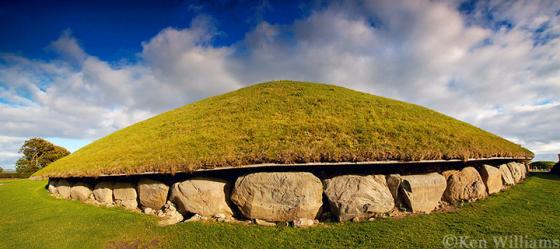Unfortunately my MP3 player crashed with a faulty hard disk (hence the delay) so I'm going to have to go on memory here, I'm very sketchy on the details.
The talk focused on a wide range of prehistoric sites and artefacts and some folk festivals, all in search for a common thread which McKie speculated as being a 14 month calendar based on solar 'events'. The year revolved around the solstices, equinoxes, cross-quater days and further divisions of these patterns.
Sites featured included Kintraw, Maeshowe, Knowth, the Bush Barrow lozenge and Nebra Disk artefacts among others.
Central to the discussion was his descripton of how he first became aware of sites with alignments to the sun and moon and how his initial skepticism led to interest and then an active investigation of the phenomenon. I think it was Kintraw that really convinced him that there was something here to be studied. At this standing stone there is an alignment to a notch further up the coast (note that he does not strictly apply Burl's insistence that both foresight and backsight must be artificial/man-made). At this site, the actual alignment (winter solstice I think) cannot be viewed from the stone, but can be viewed from a slope further away. Conveniently there is a small mound here, excavation proved that the mound was in fact artificial.
He moved on the Maeshowe which apparently has calendar alignments along the horizon in front of the mound which may be linked to a nearby standing stone.
From there he moved on to the Bush Barrow Lozenge (pic can be found here: http://www.stone-circles.org.uk/stone/normantondown.htm ) which, it had been proposed, was an instrument used to determine the dates of the solar calendar using it's geometric lines and imaginary lines radiating out from intersection points.
He contrasted this with the Nebra Disk which he proposed carried out a similar function though more abstractly (and pointed out both were found at almost the exact same latitude at which the 'functions' were accurate).
From there he moved on to the Knowth Kerbstone which he had just inspected that day, only to find that the drawing he had been using to cast a link with the above calender devices (by N.L. Thomas) had details marked out which obviously were not visible on the actual stone due to damage. I'm not sure if he came to claim the kerbstone for the calendar theory or disprove it but the end result was inconclusive of course.
Though feast days do still mark the old cross quater and solstices, the instruments of the proposed calendar were not overly convincing in my view, and of many present, nevertheless it was an informative talk and it was also nice to see an authority looking into these matters with an open mind and a thirst for backed-up evidence.
